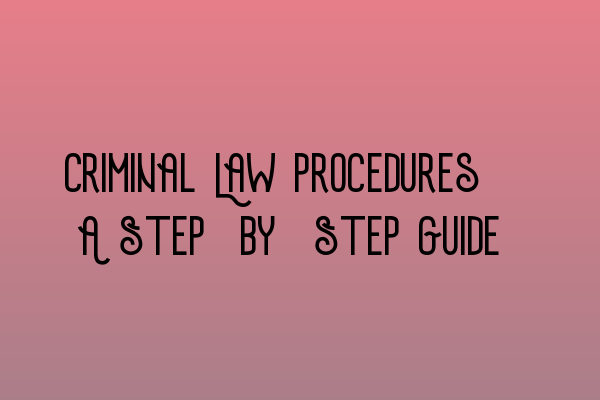Criminal Law Procedures: A Step-by-Step Guide
Welcome to SQE Criminal Law & Practice Law UK, where we provide comprehensive resources and guidance to help you navigate through the complex world of criminal law. In this blog post, we will take you through the step-by-step procedures involved in criminal law cases, ensuring you have a clear understanding of the process.
Before we dive into the details, make sure to check out our SQE 1 Practice Exam Questions and SQE 1 Practice Mocks FLK1 FLK2 to assess your knowledge and enhance your preparation.
Step 1: Investigation
The criminal law procedure begins with the investigation stage. Law enforcement agencies and/or private investigators gather evidence and information to determine if a crime has been committed and identify potential suspects. This phase can involve witness interviews, forensic analysis, and other investigative techniques.
If you’re interested in learning more about the investigative process, consider enrolling in our SQE 2 Preparation Courses, where we cover the essential skills and knowledge required to conduct thorough investigations.
Step 2: Arrest
If the authorities have sufficient evidence to believe that a crime has been committed by a specific individual, they may proceed with an arrest. The arrested person is then taken into custody and informed about their rights, including the right to remain silent and the right to legal representation.
For a detailed understanding of the arrest procedure and how it impacts the subsequent steps, consider enrolling in our SQE 1 Preparation Courses, where we provide in-depth insights into criminal law procedures.
Step 3: Charging
After the arrest, the prosecuting authority evaluates the evidence gathered during the investigation and decides whether to formally charge the arrested person with a criminal offense. This decision is based on the strength of the evidence and whether it is in the public interest to proceed with the prosecution.
To stay updated with the latest SRA SQE Exam Dates and ensure you are aware of the timeframe involved in criminal law procedures, visit our dedicated page: SRA SQE Exam Dates.
Step 4: Bail
If the individual is charged, they may be granted bail, allowing them to be released from custody until their trial. However, in certain cases where there is a risk of flight or a potential threat to public safety, bail may be denied, and the individual remains in custody until their trial.
Step 5: Pre-trial Proceedings
Prior to the trial, both the prosecution and defense engage in pre-trial proceedings, where they exchange information and evidence, file motions, and prepare legal arguments. This stage plays a crucial role in shaping the trial strategy and identifying potential areas of dispute.
Step 6: Trial
The trial is the central stage of the criminal law procedure, where the prosecution presents its case, and the defense has the opportunity to challenge the evidence and present its own case. Witnesses may be called to testify, and both sides have the chance to cross-examine the witnesses.
Step 7: Verdict and Sentencing
After hearing all the evidence and arguments, the judge or jury deliberates and reaches a verdict. If the verdict is “guilty,” the court proceeds to the sentencing stage, where the appropriate punishment is determined based on various factors, including the severity of the offense and the defendant’s criminal history.
We hope this step-by-step guide to criminal law procedures has provided you with valuable insights into the legal process. If you have any further questions or need assistance, feel free to reach out to us at SQE Criminal Law & Practice Law UK.
Remember to visit our website for more resources and courses to help you succeed in your criminal law career!
Related Articles:
- SQE 1 Practice Exam Questions
- SQE 1 Practice Mocks FLK1 FLK2
- SQE 2 Preparation Courses
- SQE 1 Preparation Courses
- SRA SQE Exam Dates
